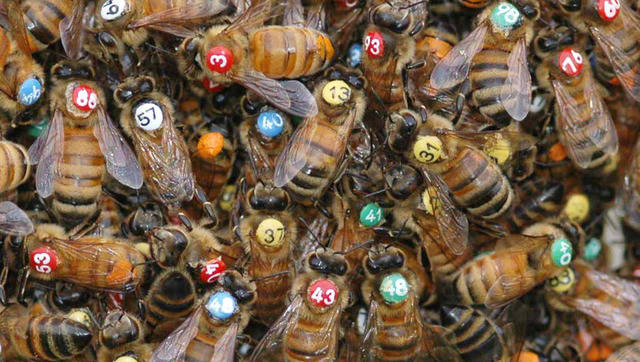
The human brain is wonderfully complex. Within it, there are billions of neurons, each collecting information and determining whether to respond to it. In some cases, groups of neurons compete for an outcome; when a group reaches a certain level of activity, its output ends up being chosen. To help make their case, these neurons can send positive signals to each other, and they can inhibit others with different agendas. Ideally, this system improves the chances of reaching an optimal decision; it’s an elegant way to make sense of lots of competing input.
As if we didn't think bees were cool enough already, Science reports this week that this approach to decision making is echoed in the behavior of honeybee swarms. Just as our neurons emit inhibitory signals, bees can hinder other hivemates that are advocating a different course of action. As with neurons, the swarm’s collective decision is made when a particular threshold is reached. But, unlike neurons, the bees have a very physical means of inhibiting those with a competing message: they headbutt them.
When a group of honeybees are ready to create a new colony, thousands of bees, along with one queen, set off from their old hive. Scout bees are faced with the task of finding a suitable nest and reporting back to their group with the location of the best nest site; the information is communicated via the famous waggle dance. Unfortunately, the scouts don’t always agree on which site is best. So how does a swarm decide where to relocate?
A group of researchers found that, upon returning to the swarm, scout bees will "headbutt" other scouts that are promoting a different nest site. This headbutt transfers a vibrational signal that, when repeated enough times, causes the other bee to stop dancing. Once a certain threshold is reached—that is, enough scouts that were advocating alternative sites have been headbutted into submission—the decision is made, and the swarm will move to the winning nest site.
The researchers created an analytic model based on differential equations, taking into account the interaction rules they learned by observing swarming bees. The model suggested that this type of cross inhibition is often necessary in order for the swarms to reach a decision. Without inhibitory signals, bees may be able to "induce" some bees to switch sides, but it's likely that enough bees will switch sides to keep the swarm from entering a stable deadlock. The use of inhibitory signals, as well as a threshold, ensures that a decision will be reached and the swarm will be in agreement as it lifts off to colonize a new nest.
While a honeybee swarm and the human brain have some aspects in common, they’re from such distinct evolutionary paths that the degree of similarity between their strategies is pretty incredible. Clearly, this type of system is a particularly effective way to make a decision that has to incorporate multiple sources of biological information.
Science, 2011. DOI: 10.1126/science.1210361 (About DOIs).
Listing image by Photograph by Thomas D. Seeley
reader comments
41